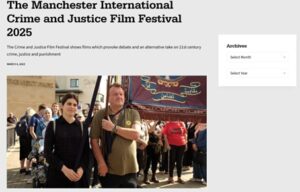Ties That Bind: Reflections on Community and Justice
| Published | 14/07/2025 |
| Author(s) | Thomas Huw Lothian Ansell |
Ties That Bind: Reflections on Community and Justice by Tom Ansell

I was recently fortunate enough to have an intern placement at the Policy Evaluation and Research Unit (PERU) to assist with the Manchester International Crime and Justice Film Festival, hosted by the PERU team at Manchester Met and gain publication experience with the BJCJ. I had assisted with the promotion of the festival, but watching ‘The Old Oak’ (15) and ‘Community Policing: All Things to All People?’ gave me a different perspective. Both films raised questions I’ve been exploring as a sociology student in Manchester over the past few years, especially through voluntary work with young people failed by the systems meant to protect them. They reminded me that justice often begins in the everyday spaces. Whether through relationships, conversations or in the environments where people feel most safe. These films offered a place to reflect on that, the role of justice and what real support can look like when grounded in care.
The Old Oak explores what happens when grief and isolation are left to fester in a divided community. TJ, a quiet pub landlord, spends much of the film trying to hold together the last community space in a former mining village that is fractured by racism, unemployment and mistrust. His pub becomes a place where meals are served and conversations happen across difficult lines. That sense of fragile solidarity is broken when the pub’s kitchen is vandalised, closing the space where members of the community had shared meals and discussion alongside families who had recently fled Syria. In the aftermath, TJ returns to the same waterside where he had once tried to drown himself. As he stands there again, his despair is clear. This time, it is not a dog but a friend who unknowingly interrupts him. The moment passes, but the weight of the scene lingers.
It took me to a moment at Rekindle, a community-led supplementary school I have been volunteering with in Hulme, Manchester. At their celebration evening, one of the young people stood up to perform a poem. In front of a packed room that included family, friends and even the Mayor of Greater Manchester, he spoke about the difference Rekindle had made in his life. He said he never would have had the confidence to speak like that before. Watching him, alongside a room full of three different generations, I saw exactly what community support can do. It was powerful in the same way Loach’s film was. Not dramatic and not romanticised, just honest moments of resilience where people stand (or sit) together. At Rekindle, that similarly meant sharing food, stories and a space. In The Old Oak, it meant fighting to keep a place alive where that kind of connection is still possible.
Community Policing: All Things to All People? offers a wry take on a century of struggles to bring police and communities together. Curated from the North West Film Archive, the film explores how the meaning of “community policing” has shifted from the 1900s to the present day. One moment in particular stood out to me. In the archival footage, a young officer casually joked about dragging local boys into court, expressing frustration that they would only just be “let off.” Although decades old, the tone reflected a culture of mistrust that still feels present today. I have seen this firsthand while volunteering in Manchester, especially among young people who feel misunderstood by authority figures. At Youth Offending Panels, I have seen the value of a more Child-First and community centred approach. These panels bring together young people, families, caseworkers and community volunteers to talk through harm and repair, rather than relying solely on punitive measures. They offer a space for listening and not judging.
This idea of collaborative justice also shaped my own research, which I conducted during my 2024 internship with the Manchester Youth Justice Service. The project explored the role of detached youth work as well as how community-based spaces can support safer outcomes for young people and inform future practice. I interviewed Dr Erinma Bell MBE, an anti-violence campaigner recognised for her work tackling gun crime in Moss Side and Longsight. She spoke about the importance of the “Parent-School-Child Triangle” and stated that youth services like Youth Justice and the Police would benefit greatly from becoming more visible and embedded within community hubs. Doing so, she explained, would allow local services to better connect with young people and to provide the support they need.
These reflections feel especially relevant as I prepare to begin training as a probation officer later this year. Community and relationships are not just themes that appear in films. They are central to how we support people through the justice system. If we want to create lasting change, we need to value the everyday spaces where trust is built, harm is understood and hope can become possible.